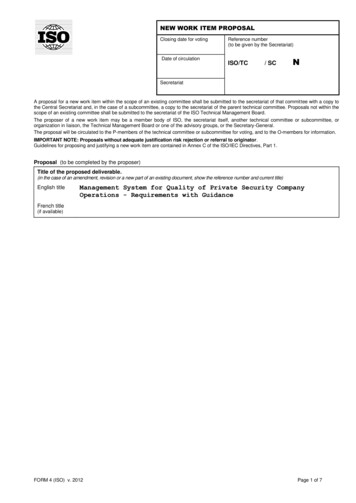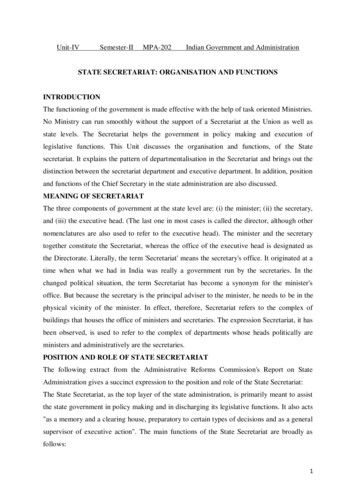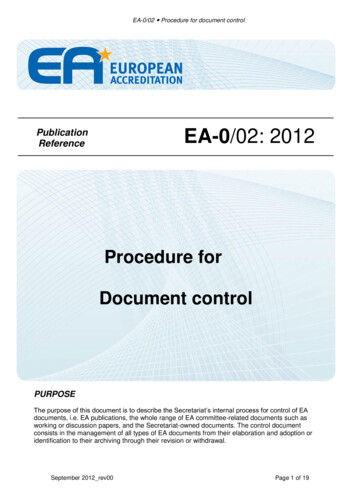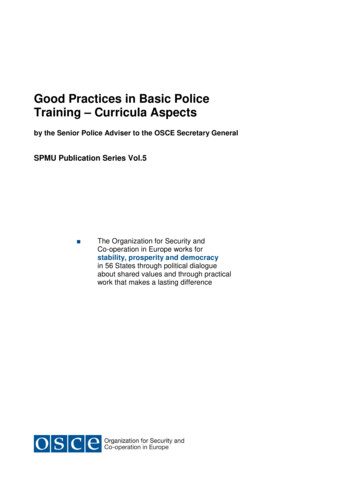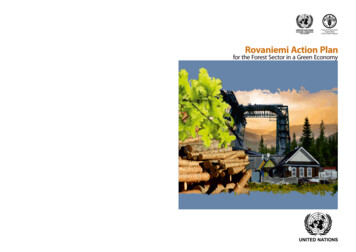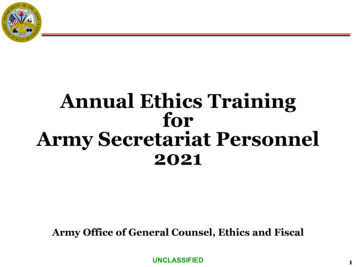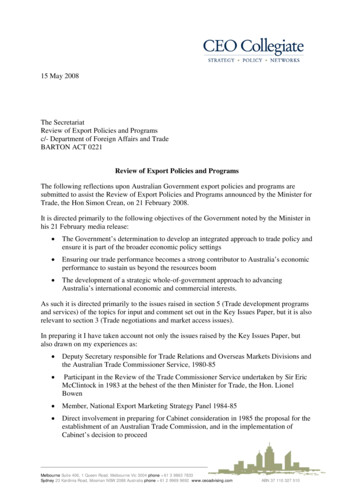
Transcription
15 May 2008The SecretariatReview of Export Policies and Programsc/- Department of Foreign Affairs and TradeBARTON ACT 0221Review of Export Policies and ProgramsThe following reflections upon Australian Government export policies and programs aresubmitted to assist the Review of Export Policies and Programs announced by the Minister forTrade, the Hon Simon Crean, on 21 February 2008.It is directed primarily to the following objectives of the Government noted by the Minister inhis 21 February media release: The Government’s determination to develop an integrated approach to trade policy andensure it is part of the broader economic policy settings Ensuring our trade performance becomes a strong contributor to Australia’s economicperformance to sustain us beyond the resources boom The development of a strategic whole-of-government approach to advancingAustralia’s international economic and commercial interests.As such it is directed primarily to the issues raised in section 5 (Trade development programsand services) of the topics for input and comment set out in the Key Issues Paper, but it is alsorelevant to section 3 (Trade negotiations and market access issues).In preparing it I have taken account not only the issues raised by the Key Issues Paper, butalso drawn on my experiences as: Deputy Secretary responsible for Trade Relations and Overseas Markets Divisions andthe Australian Trade Commissioner Service, 1980-85 Participant in the Review of the Trade Commissioner Service undertaken by Sir EricMcClintock in 1983 at the behest of the then Minister for Trade, the Hon. LionelBowen Member, National Export Marketing Strategy Panel 1984-85 Direct involvement in preparing for Cabinet consideration in 1985 the proposal for theestablishment of an Australian Trade Commission, and in the implementation ofCabinet’s decision to proceedMelbourne Suite 406, 1 Queen Road, Melbourne Vic 3004 phone 61 3 9863 7833Sydney 23 Kardinia Road, Mosman NSW 2088 Australia phone 61 2 9969 9692 www.ceoadvising.comABN 37 110 327 510
Special Trade Representative for North Asia, 1985-88 Special Adviser/Deputy Secretary DFAT, 1988-91 Executive Director, Business Council of Australia, 1992-96 Secretary, Department of Primary Industries and Energy, 1996-98 Secretary, Department of Defence, 1998-99.I would of course be happy to elaborate any issues that you would care to take up with me.Yours sincerely,(Paul Barratt)
CEO COLLEGIATE PTY LTDSubmission to Review of Export Policies and Programs13 May 2008REFLECTIONS ON AUSTRADE AND THETRADE DEVELOPMENT ROLE OF GOVERNMENTINTRODUCTIONThis paper has been prepared in response to the Government’s invitation to interested partiesto make submissions relating to the Panel which has been appointed by the Minister for Tradeto conduct a comprehensive Review of Australia’s Export Policies and Programs. It addressesin particular issues relating to the Australian Trade Commission (Austrade) and the role whichAustrade might play in acting as a strategic instrument of Australian trade policy. Specifically,the paper sets out to address the following: A brief overview of the role of Government trade strategy and in this context, howAustrade might be positioned as a strategic instrument of government trade andeconomic development; How Austrade can make the biggest difference to Australian business, consistent withAustrade’s role as a government service delivery agency, and the differing nature ofthe services that will best meet the needs of large businesses, on the one hand, andsmall and medium enterprises (SMEs) on the other; An overview of how Austrade is placed within the broader canvass of Australian tradepolicy and possible ways of adding value to the Government’s policy agenda.After presenting some relevant background to the establishment of Austrade, the paperaddresses The policy context within which the Review is being conducted General strategic approaches to trade development and the delivery of tradedevelopment services The public interests that an official export promotion body can serve, and the means bywhich they can be served The important distinction to be drawn between “trade promotion” and the much morestrategic function “trade development” The broad strategic choices available to the government concerning the mandate itcould choose to give to Austrade Some examples of strategic approaches to trade development in which the author waspersonally involved, and the lessons that might be drawn from them In the light of the analysis and examples presented, further consideration of the ways inwhich Government export programs can address the needs of Australian business inthe public interest A number of issues relevant to the structure and modus operandi of Austrade that willneed to be taken into account by the Review, including the legislative framework, usercharges, the disposition of resources, and issues relating to high level lateralrecruitment.1
CEO COLLEGIATE PTY LTDSubmission to Review of Export Policies and Programs13 May 2008POLICY CONTEXT: THE GOVERNMENT’S EXPORT OBJECTIVESThe trade policy statement A Strong Future for Australia’s Exports establishes a wide rangingagenda that the Review will need to address. Some of this is specific to the current exportassistance programs delivered by Austrade, but the desire for a more strategic whole-ofgovernment approach means that the Review will need to consider how Austrade’s on-theground delivery of programs can be integrated into the Government’s broader policyobjectives and meshed with the activities of other agencies without creating ponderouscoordination mechanisms that hamper the effectiveness of all the agencies.The Overview section of the Statement notes a number of concerns and requirements that setthe policy context for the Government’s trade policy and strategy: The current resources boom has masked Australia’s poor export performance Despite the strong global demand, Australia continues to register a large trade deficit The commodity boom alone will not secure Australia’s future prosperity Strong and sustained export growth is essential for Australia’s long term economicprosperity and for providing well paid, rewarding jobs The sustained export growth we need will occur only if Australia’s trade promotionpolicies, programs and structures are renewed and reinvigorated Export policies and programs that position us to take maximum advantage of theongoing resources boom and to grow exports from other sectors of the economy arerequired We need policies that are suited to the needs not only of our traditionally strongexporting sectors but also to small business and the growing opportunities for theservices and financial services sectors The business community has recognised that there is a clear need to update andreinvigorate trade policies and programs.The policy statement goes on to say: Labor will provide Australian businesses, especially small businesses and those in theservices sector and in regional areas, with the help they need to take their products andservices to the world and to meet the challenges and competition of the global marketplace. Labor sees real potential for increasing exports from the manufacturing sector,particularly in elaborately transformed manufactures, and from the interface betweenthe manufacturing and services sectors in areas such as design and the provision ofexpertise. In trade negotiations a Rudd Labor Government will focus on achieving the bestpossible outcomes for the nation and for Australian business, particularly throughmultilateral structures. Labor believes there is an ongoing role for bilateral andregional agreements, especially where they are consistent with and can contribute tomultilateral outcomes.2
CEO COLLEGIATE PTY LTDSubmission to Review of Export Policies and Programs13 May 2008 Austrade and its programs will be reinvigorated, and complemented with a newbusiness advisory body, to make it more adaptable and responsive to business concernsand to new export opportunities. In particular, a Rudd Labor Government wouldcoordinate its industry, trade and regional development policies to provide businesswith better integrated government support.My one comment about the above at this point is that there is not only an ongoing role forbilateral trade agreements; there is also a very important trade development role for bilateraltrade strategies that target key industry sectors in key markets on the basis of currentlyavailable access and hence do not require the negotiation of a government-to-governmentagreement as a pre-condition for making progress.BACKGROUND TO THE ESTABLISHMENT OF AUSTRADEThe Australian Trade Commission (Austrade) commenced operations in 1986 as the successorto the Australian Trade Commissioner Service.The Australian Trade Commissioner Service consisted of about 160 Trade Commissionersappointed under the Australian Trade Commissioners Act 1933 by the Governor-General onthe recommendation of the Minister for Trade1. They were appointed for fixed terms(normally three years); appointments were normally renewed until the Trade Commissionerretired or resigned. Support staff were Public Service Act staff (on diplomatic postings) orlocally engaged staff.In-country services were provided to Australian business visitors free of charge, and thephilosophy was that all businesses that sought assistance were entitled (within reason) toreceive it to the extent that the post had the resources required to deliver the service.In a number of posts the Senior Trade Commissioner was Head of Mission, normally ConsulGeneral (Bahrain, Osaka, Rio de Janeiro), sometimes Ambassador (Algiers) or Chargéd’Affaires (Tripoli).The functions of individual posts lay somewhere on the spectrum between pure policy poststhrough trade development to pure trade promotion posts. Posts like Brussels, London, Paris, Buenos Aires and Rio de Janeiro were at the policyend of the spectrum. The Senior Trade Commissioner was typically a seniordepartmental officer on a single posting. The focus of the work was often liaison withthe host government on trade access negotiations under way in multilateral fora, butthe work in Rio de Janeiro and Buenos Aires involved bilateral liaison on commoditiesissues that could be seen as precursors to the establishment of the Cairns Group for thepurposes of the Uruguay Round.1Note that the abolition of the Trade Commissioner Service and the replacement of its functions by Austradetook place prior to the 1987 merger of the Departments of Trade and of Foreign Affairs. In the early yearsfollowing the merger Austrade was responsible to the Minister for Industry and Commerce, so it was for the firsttime in the history of the Trade Commissioner function in a different portfolio from the trade policy function.This may have contributed to the establishment of a culture in which “trade policy” and “trade promotion” wereseen by most on both sides of the (rather spurious) boundary to be distinct functions. As the paper endeavours tomake clear, integration of these functions is a key issue for the Review to address.3
CEO COLLEGIATE PTY LTDSubmission to Review of Export Policies and Programs13 May 2008 Further along the spectrum were “trade development” posts, typically in difficultmarkets in which the work was a combination of identifying commercial opportunities,identifying companies that could be competitive in accessing those opportunities,assisting them in developing their strategy, and supporting them with the necessarygovernment to government representations. Posts like Beijing, Jeddah/Riyadh,Algiers, Jakarta fall into this category. As the case notes below illustrate, at timesthese posts could succeed in creating for Australian firms commercial opportunitiesthat would not be available to companies acting on their own. At the trade promotion end of the spectrum were posts typically in open developedcountry markets in which Australian companies could sell a wide range of goodsprovided they were competitive and were marketed adequately. The job was more inthe nature of advising and facilitating Australian companies than breaking down accessbarriers or penetrating an opaque bureaucracy.Because the individual Trade Commissioners were accountable to and under the direction ofthe Minister, who was in turn advised by the Department, the Trade Commissioner arm of theportfolio was effectively directed by the Department (an operating arm of the portfolio as awhole) and it was very easy to mount integrated campaigns such as the 1980s China ActionPlan and Japan Market Strategy which had strong elements of trade policy, trade developmentand marketing2. A corollary of this was that there was no great need to consider where theboundaries of Departmental responsibilities lay vis-a-vis the Trade Commissioner Service.Nor was there a jurisdictional issue relating to whether individual overseas posts were“policy” or “marketing” posts3.The philosophical underpinning of the decision to establish the Australian Trade Commissionwas a belief that: Users of the services provided by Trade Commission posts ought to be required to payfor the services they receive Services for which the users were not prepared to pay the cost of provision were ofdoubtful benefit to anyone and therefore probably ought to be wound down Accordingly, the provision of trade commissioner services should be placed on a morebusiness-like footing in a statutory authority which could charge for its services andraise a high proportion of its budget from user charges This statutory authority ought as far as possible to look and to operate like a privatebusiness.2A detailed account of these programs and the lessons to be drawn from them was published by the author in theearly 1990s – see Paul Barratt, “Winning Asian markets in the eighties: a model for the nineties”, AustralianQuarterly, Summer 1992. The text of this paper is reproduced at Attachment A.3The functional cost of disaggregating the two functions we explicitly recognised at the time that Austradecommenced formal operation. Austrade remained co-located with the Department of Trade in the EdmundBarton Building, and the staffs of the various area desks were deliberately located in close proximity to facilitateday-to-day consultation and collaboration This close collaboration inevitably began to become more distantwhen the two bodies moved to different portfolios and Austrade moved to its own headquarters building.4
CEO COLLEGIATE PTY LTDSubmission to Review of Export Policies and Programs13 May 2008GENERAL APPROACHESWhy have Austrade?The thinking which underpinned the conversion of the Australian Trade CommissionerService into Austrade was not very deep, to say the least. If Austrade could raise most or allof its fees from its clients, the question which immediately arises is why it is not operating inthe private sector4. Questions of competitive neutrality also arise in relation to anyGovernment operation that is some kind of trade consultancy, because its activities inevitablycompete with private sector trade consultants.A more appropriate way in which to consider the positioning of Austrade in the Australianpublic sector space is to consider it from a public policy and public interest perspective. Farfrom measuring Austrade’s performance and relevance by the extent to which it can recoverits costs through user charges (in effect a proxy for how much the client base values theservices), Austrade should be measured on the basis of the extent to which the public benefitsit brings are judged sufficient justification for its net cost to government. This is of coursemuch more difficult to measure than gross (or net) revenue, but in relation to a governmentagency whose justification rests on public interest grounds it is the only relevant measure. Itshould not be difficult to establish clear and consistent principles on which to assess whereAustrade or government as a whole has made a material contribution to achieving an outcomethe benefits of which accrue outside government in the first instance.The central question concerning Austrade is the extent to which it is to be a strategicinstrument of public policy (the tenor of the terms of reference of the current Review), or agovernment service provider primarily directed to assisting SMEs. Put another way, is it tohave a strategic function or is it intended simply to operate at the tactical level? To judge bythe current Act, the answer at present is resoundingly the second (less ambitious) of these twopossibilities. The overarching phrase in S.8 is “to facilitate and encourage trade”. These arenot quality goals in the sense of being sufficiently specific to enable clear visibility of whetherthey are being achieved. Nor are they challenging.The trade policy presented by the Government during the recent election (see above) makesquite clear that the Government intends Austrade to play a strong role in the strategic realm.In that regard it is important at this stage to establish a clear picture of what is meant by theterm “strategy”. Strategy is an overworked and much misused word, all too often confusedwith “tactics”, both regarded as interchangeable synonyms for “a plan”.In this paper the term “tactics” refers to the application of professional skill, disciplines andprocedures to maximising the chances of success in the circumstances of the day. Tactics areimportant: they can and should involve a high standard of innovation, responsiveness andprofessionalism.4Indeed in 1992 then Opposition spokesman Alexander Downer declared to the author that the Coalition wouldprivatise Austrade when it returned to office.5
CEO COLLEGIATE PTY LTDSubmission to Review of Export Policies and Programs13 May 2008The terms “strategy” and “strategic” are used to refer to plans and actions directed not simplyto doing the best we can within the operating environment as it exists, but to influencing theoperating environment in our favour, in order to achieve a substantial improvement in ourchances of success. It is about changing the rules of the game, about shaping events, not justresponding to them5.The core question addressed in this paper is how Austrade can best address the strategic issuesin Australian trade policy and programs.The public interests that Austrade can serve include: Contribution to Australia’s trade performance (reduction of current account deficit) inways such as the following; examples given are from the 1980s China Action Plan6:¾ Using the high level access available to senior government officials to discern newand emerging opportunities in difficult markets in a timely manner, positionsuitably capable businesses to capture the opportunities, and use the high levelaccess to support the efforts of the relevant Australian businesses. Shun Chang Cement Plant (BHP Engineering) Effort to reopen Kwinana blast furnace (BHP-Chinese Ministry ofMetallurgical Industry (MMI)-WA Govt) CITIC investment in Portland Aluminium Smelter Chinese investment in Mount Channar Iron Ore Mine¾ Organisation and management of high level missions which will obtain very highlevel access in the target market Transport mission led by Sir Peter Abeles under the sponsorship of PrimeMinister Hawke¾ Development of integrated industry plans with clear targets and assigned roles forgovernment and industry participants China Iron and Steel Wool Initiative Transport Initiative5The Hawke Government’s China Action Plan described in the article attached to this paper was deeply strategicin its nature and intent. It aimed to transform the environment for Australian business in China by establishingeffective working relationships between political leaders and relevant senior officials; using these relationships tobe ahead of the game as new programs or reforms created new opportunities; influencing patterns of investmentin both directions; demonstrating that we took China’s economic reform program seriously; and obtainingprivileged access for representatives of key Australian businesses. The early results were sufficientlyencouraging that the Prime Minister’s Economic Adviser, Ross Garnaut, a key driver of the program, wasappointed Australian Ambassador to China (1985-88) and the author of this paper was appointed Special TradeRepresentative for North Asia (1985-88), based in Canberra. Upon his return from his posting in Beijing DrGarnaut was commissioned to undertake the review that was published as Garnaut, R. 1989, Australia and theNorth-East Asian Ascendancy: Report to the Prime Minister and Minister for Foreign Affairs and Trade,Australian Government Publishing Service, Canberra.6See Attachment A.6
CEO COLLEGIATE PTY LTDSubmission to Review of Export Policies and Programs13 May 2008¾ Working with international financial institutions and local authorities to createinfrastructure solutions for which Australian firms would be highly competitive;assemble and manage the Australian bid consortium. Shanghai Liquid Waste (consortium that became Heavy EngineeringManufacturers Association of Australia, HEMA)¾ Assembling and project managing consortia to respond to foreign governmentrequests for tender Dong Du (Fujian Port) Stage II¾ Assist in the injection of Australian industry into supply chains for highlyglobalised industries. I believe there are important opportunities to do this with Defence primes forwhich Australia is an important market. Improving the performance of individual exporters¾ Market intelligence, especially in developing country markets¾ Advice to SMEs (eg on specifics of particular markets or opportunities)¾ Introduction to potential clients with a clear interest in the product¾ Mentoring high priority firms throughout their negotiations until the negotiationsare successful or abandoned, e.g., from the 1980s Japan Market Strategy (nontraditional exports to Japan) Budget car rental joint venture Australian wine exports Sheridan sheets (Pacific Dunlop)¾ Direct delivery of export development skills and services into regional centres inAustralia¾ Export trade skills training¾ Advice to first-time exporters, or to exporters exporting to a particular market forthe first time Contributing to Government trade policy agenda¾ Identification of trade impediments that have a significant impact on Australianexporters¾ Identification of emerging opportunities in difficult markets¾ Identifying opportunities for Government to support export and investment effortsof major significance Prioritisation of the access negotiations agenda, especially at the bilateral level: energyshould only be expended on access negotiations that serve an identifiable commercialinterest – access negotiations are not ends in themselves. There is no point in trying tokick open a door that no one is waiting to go through.7
CEO COLLEGIATE PTY LTDSubmission to Review of Export Policies and Programs13 May 2008Trade developmentIt will be evident from the above that there is a wide range of functions that is neither “tradeaccess negotiations” in the sense of the Doha Round or a bilateral Free Trade Agreement(FTA), nor “trade promotion” in the sense of taking known goods and services and seekingsimply to match the suppliers with buyers. Nor does much of it require the negotiation of abilateral agreement, although these can help to expand the available opportunities.Some of the most important opportunities lie in the realm of “trade development”, whichmight for example involve creating an interface between an entity with a problem (e.g. anational or provincial government agency) and an entity or group of entities that can develop asolution. Helping the foreign entity to scope the problem might well be central to creating theopportunity, particularly in the less advanced economies or regions.The great strength if this approach is that it is market driven – we start with the customer andgo looking for the Australian supplier(s) who can meet the need, rather than the more supplydriven approach of starting with an industry sector (within which the firms often seethemselves as being in vigorous competition) and looking for markets.The time-scales of international tradeOver the years there has been much confused discussion and comment about the relativemerits of multilateral and bilateral trade policy/strategy, much of which indicates apresumption that the two are in conflict and that there is a choice to be made between them.In fact each of them has an important place and the nation’s trade diplomacy should be seen interms of action on three different timescales: In true multilateral trade negotiations we are envisaging the world as we would like itto be, and setting out to achieve the closest approximation to it that we can. Inevitably,the timescales are very long. That is not a criticism, but it needs to be recognised thatthis is a form of investment in the future, not a way of achieving near-term rewards.Time required is years to decades. The intermediate time horizon (months to a small number of years) involves¾ The bilateral negotiation of trade access, directed not only to Free TradeAgreements but also for example to the many opportunities to negotiatemodifications to or repeal of legacy protection schemes7.¾ The construction of market strategies such as the highly successful Hawke-eraChina Action Plan and Japan Market Strategy.7As economies evolve, a variety of tariff and non-tariff barriers can outlive their usefulness to the host nation,but they are often not repealed in the absence of specific reason to do so. Often they are traded away in thecontext of multilateral trade rounds, but the timescales of comprehensive multilateral trade negotiations are solong that new opportunities for change can arise during or between rounds . With a constructive workingrelationship with the relevant overseas ministries, specific changes can be negotiated quite simply provided thereis a demonstrable commercial rationale for doing so. Typically any changes are made on a global basis so that allcountries benefit from these “housekeeping” changes.8
CEO COLLEGIATE PTY LTDSubmission to Review of Export Policies and Programs13 May 2008¾ The establishment of industry-specific export strategies. The shortest time horizon (weeks to months) accepts the world exactly as it is todayand seeks to maximise our achievement on a commercial basis, supported bygovernment wherever this can add value.Item three above is the traditional “trade promotion” or “marketing” function and is to bedistinguished from the “trade development” functions embodied in item two.Potential ambit of operationAustrade could offer to meet the needs of any government in one of three ways: A strict focus on its traditional (current) role – facilitating and encouraging trade, andperhaps operating somewhat more strategically as a trade development agency, whileessentially limiting its focus to what it can achieve with its own powers and resources. A strong contributor to an integrated Foreign Affairs and Trade portfolio approach toAustralia’s commercial and economic relations with the world – bringing itsknowledge and skills to the processes of setting the wider agenda, and producing, inconsultation with Departments such as the Department of Agriculture, Forests andFisheries and the Department of Infrastructure, Energy and Resources, coordinatedDFAT/Austrade/AusAID action plans to be implemented with the involvement of allthree agencies as required. Assist the portfolio as a whole to bring the necessary international perspective tosetting the domestic agenda in areas such as education, skill formation, infrastructureinvestment, participation in international collaborative schemes such as the HumanGenome Project, the Intelligent Manufacturing Project etc. In the age of globalisationthe domestic economic agenda are not just a matter of doing things better than we didthem last year – it is necessary to ensure that we are doing them better than ourcompetitors8.Austrade’s current core offering is the first of the above and it must always ensure that it canperform these basic functions well, but it is presumably a key objective of the current Reviewto consider how much more could be achieved.BILATERAL TRADE STRATEGIES - CASE NOTESThe following examples from past programs are offered to illustrate the types of strategicapproaches that can have a transformative approach to Australia’s trade performance inspecific markets. A fuller account can be found in the paper at Attachment A.8The Hawke-Garnaut thinking about the integration of key industry sectors in Australia and China was deeplyconnected to their thinking about liberalisation of the Australian economy and selling the case for difficultreforms to important domestic constituencies.9
CEO COLLEGIATE PTY LTDSubmission to Review of Export Policies and Programs13 May 2008China Action PlanThe China Action Plan was developed as a specific initiative to respond to a joint statementissued in early 1983 by Prime Minister Hawke and Premier Zhao Ziyang, to the effect that thetwo governments would work hard to enhance trade and investment in both directions. Thekey feature of the program was ensuring sufficient impact and follow-through by targeting asmall number of provinces and a small number of industry sectors.Commercial risk to Australian enterprises was greatly reduced by: Establishing working relationships with senior officials in the targeted provinces, andmaking regular visits Obtaining hard intelligence on the projects which had high priority in the provincialplans Consulting central authorities on the status of those plans, e.g. whether the project hador would soon receive the necessary allocation of hard currency Giving firms with the requisite capability direct introduction to the provincial officialsresponsible for the projects Providing advice on outstanding issues during the course of neg
c/- Department of Foreign Affairs and Trade BARTON ACT 0221 Review of Export Policies and Programs The following reflections upon Australian Government export policies and programs are submitted to assist the Review of Export Policies and Programs announced by the Minister for Trade, the Hon Simon Crean, on 21 February 2008.


